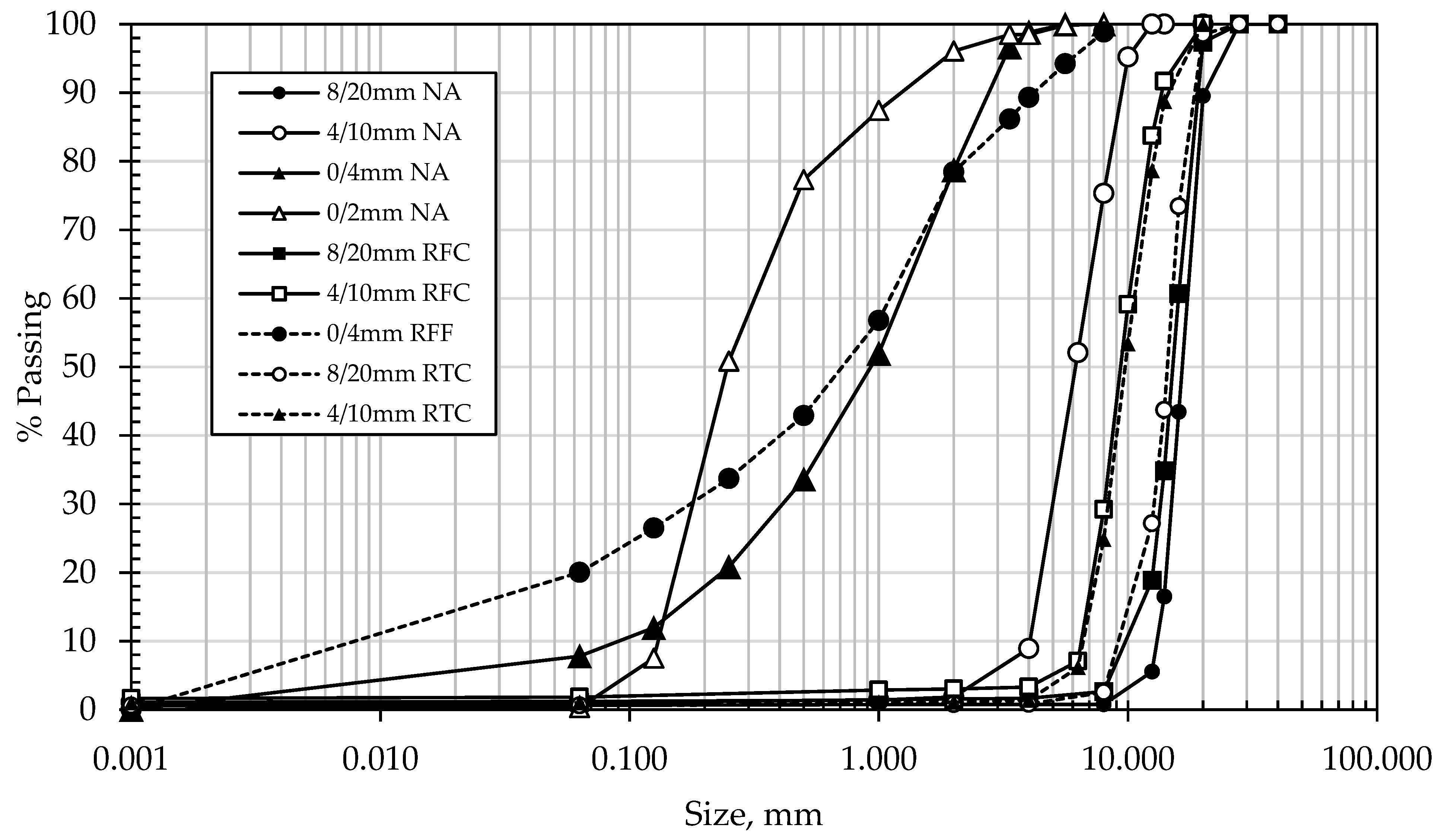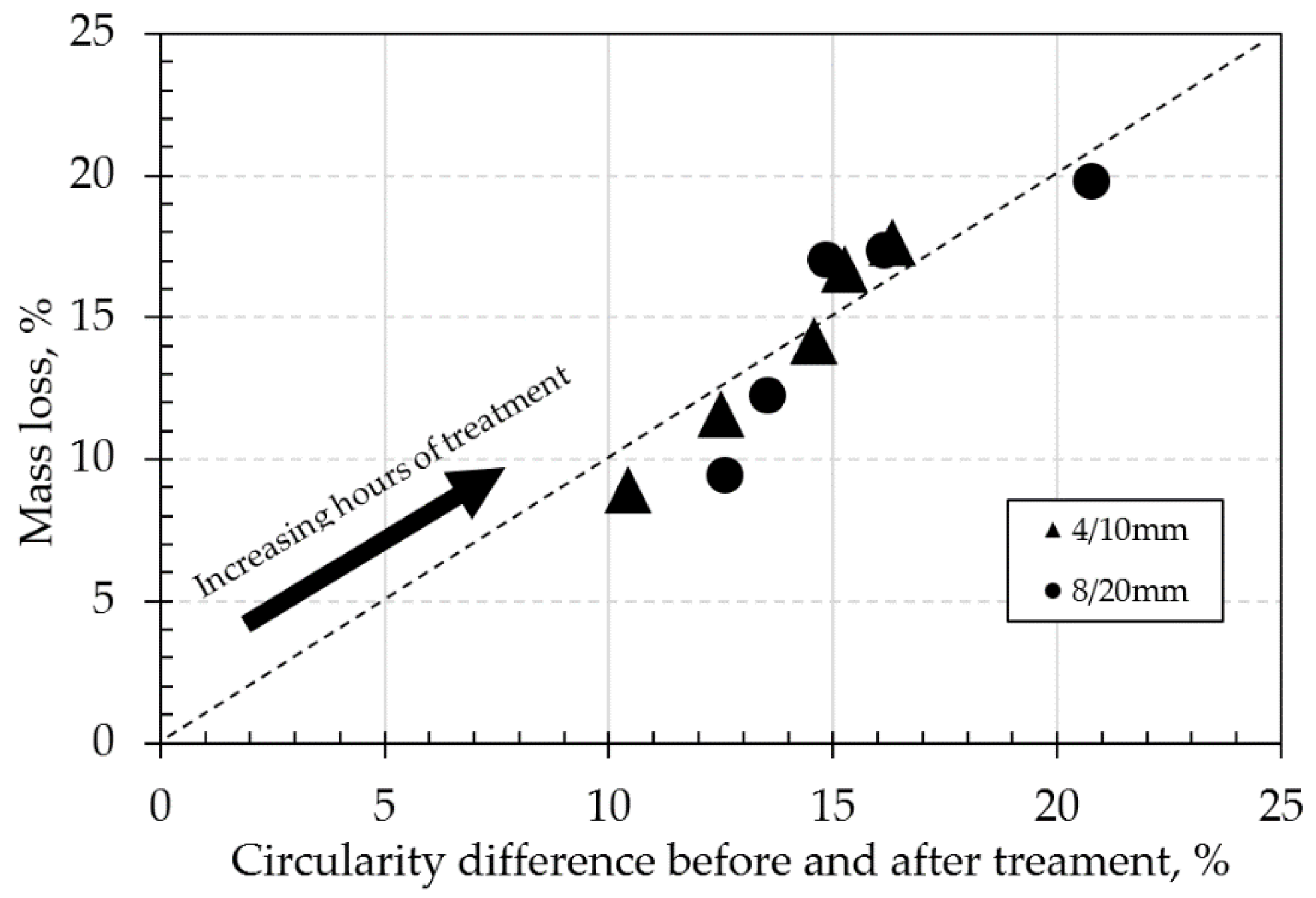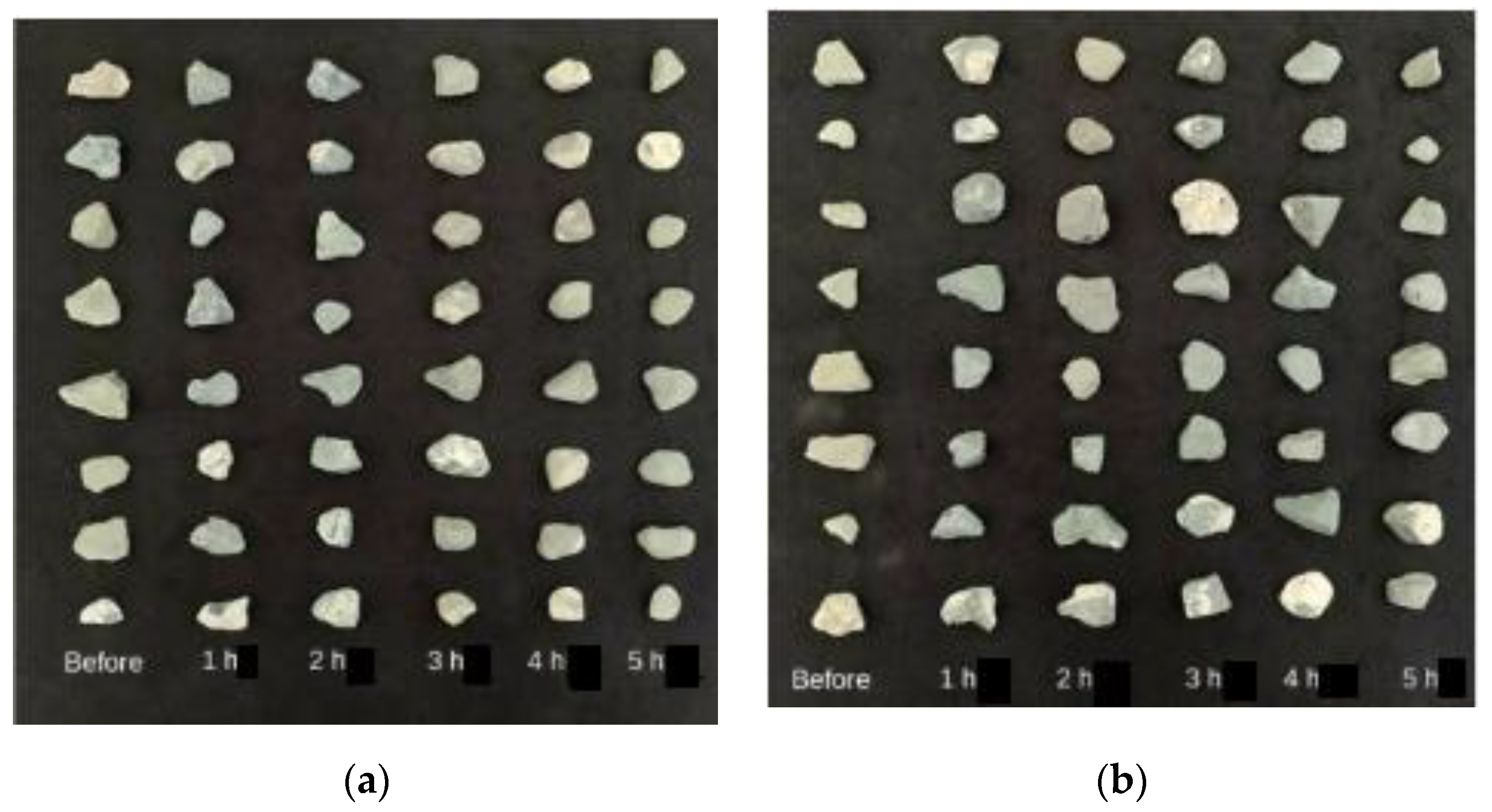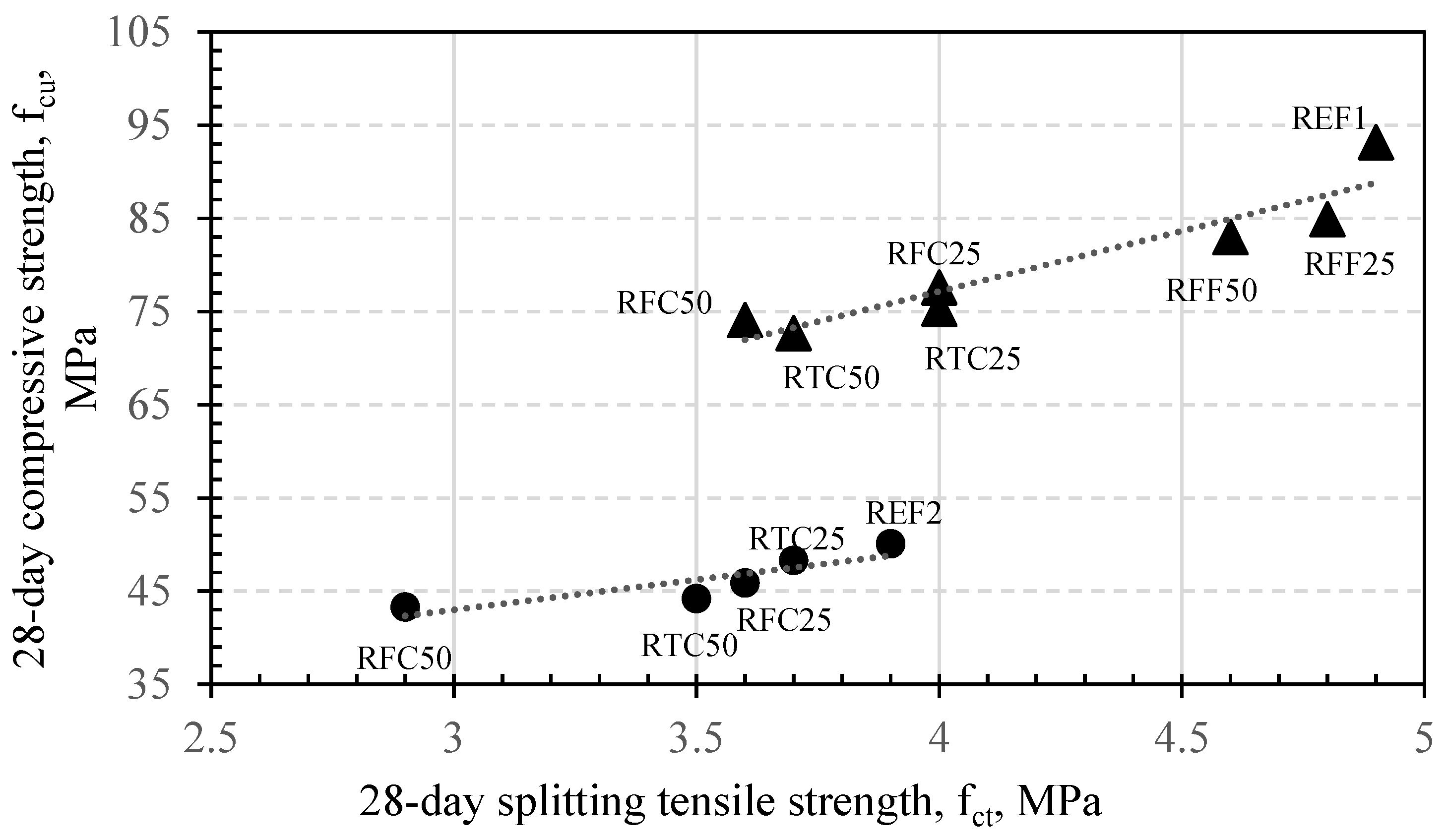A Mechanical Treatment Method for Recycled Aggregates and Its Effect on Recycled Aggregate-Based Concrete
Abstract
:1. Introduction
2. Materials and Methods
2.1. Mechanical Treatment of Aggregates
- m1
- is the dried sample mass before treatment (g);
- m2
- is the dried sample mass after treatment (g).
- A
- is the area of the aggregate (mm2);
- P
- is the perimeter of the aggregate (mm).
2.2. Concrete Properties Investigated
- Q
- is the amount of 2-propanol absorbed (g);
- ρ
- is the density of propanol (g/mm3);
- A
- is the cross-section area exposed to propanol (mm2);
- t
- is the time (min);
- k
- is the sorptivity coefficient (mm/s0.5).
2.3. Mixtures and Mixture Proportions
- “R” for RCA.
- “F” for fine aggregates replacement (second letter in formulation nomenclatures).
- “C” for coarse aggregates replacement.
- “F” for field non-treated (third letter in formulation nomenclatures).
- “T” for treated.
- “50” or “25” represent the replacement percentage of NA.
2.4. Casting and Curing
3. Results and Discussion
3.1. Circularity and Mass Loss
3.2. Mechanical Properties
3.3. Durability Properties
4. Conclusions
- An optimal duration for mechanical treatment of RCA (beyond that, no significant changes in circularity and mass loss of RCA were observed) was found to be 3 h. This was further evidenced through a large-scale treatment process that yielded comparable circularity differences.
- At low w/c ratios, higher replacement contents of coarse RCA, either treated or untreated, reduced both compressive and tensile strengths of concrete mixtures at 28 days. When incorporating recycled fine aggregates, and particularly at a replacement content of 25% by mass, the compressive and tensile strengths of concrete mixtures were the closest to those of the reference.
- Durability properties seem to be slightly affected by the addition of recycled aggregates. A 3 h treatment on aggregates, which were incorporated at high replacement percentages within low w/c ratio mixes, led to an increase in the sorptivity coefficients by almost 20%, although it maintained the chloride resistance at comparable levels to those of concretes containing untreated aggregates at high amounts.
- It was observed that in concretes of w/c ratio 0.50, the incremental addition of 3 h mechanically treated aggregates at 25% and 50% by mass reduced the sorptivity coefficients at a linear rate (approximately a 0.0011 mm/s−0.5 difference for each increment). These changes were more drastic than those that occurred in concretes of low w/c ratios. Such reduction indicates a beneficial effect due to the mechanical treatment which enhanced the pore network of the investigated concretes.
Author Contributions
Funding
Institutional Review Board Statement
Informed Consent Statement
Data Availability Statement
Acknowledgments
Conflicts of Interest
References
- Kanellopoulos, A.; Nicolaides, D.; Petrou, M.F. Mechanical and durability properties of concretes containing recycled lime powder and recycled aggregates. Constr. Build. Mater. 2014, 53, 253–259. [Google Scholar] [CrossRef]
- Kanellopoulos, A.; Petrou, M.F.; Ioannou, I. Durability performance of self-compacting concrete. Constr. Build. Mater. 2012, 37, 320–325. [Google Scholar] [CrossRef]
- Kanellopoulos, A.; Savva, P.; Petrou, M.F.; Ioannou, I.; Pantazopoulou, S. Assessing the quality of concrete–reinforcement interface in Self Compacting Concrete. Constr. Build. Mater. 2020, 240, 117933. [Google Scholar] [CrossRef]
- Poon, C.; Shui, Z.; Lam, L. Effect of microstructure of ITZ on compressive strength of concrete prepared with recycled aggregates. Constr. Build. Mater. 2004, 18, 461–468. [Google Scholar] [CrossRef]
- Commision & Brundtland. Report of the World Commissio n on Environment and Development; United Nations: New York, NY, USA, 1987. [Google Scholar]
- Matias, D.; de Brito, J.; Rosa, A.; Pedro, D. Mechanical properties of concrete produced with recycled coarse aggregates—Influence of the use of superplasticizers. Constr. Build. Mater. 2013, 44, 101–109. [Google Scholar] [CrossRef]
- Kazemian, F.; Rooholamini, H.; Hassani, A. Mechanical and fracture properties of concrete containing treated and untreated recycled concrete aggregates. Constr. Build. Mater. 2019, 209, 690–700. [Google Scholar] [CrossRef]
- Dimitriou, G.; Savva, P.; Petrou, M.F. Enhancing mechanical and durability properties of recycled aggregate concrete. Constr. Build. Mater. 2018, 158, 228–235. [Google Scholar] [CrossRef]
- Qiu, J.; Tng, D.Q.S.; Yang, E.-H. Surface treatment of recycled concrete aggregates through microbial carbonate precipitation. Constr. Build. Mater. 2014, 57, 144–150. [Google Scholar] [CrossRef]
- Ismail, S.; Ramli, M. Mechanical strength and drying shrinkage properties of concrete containing treated coarse recycled concrete aggregates. Constr. Build. Mater. 2014, 68, 726–739. [Google Scholar] [CrossRef]
- Xiao, J.; Li, W.; Fan, Y.; Huang, X. An overview of study on recycled aggregate concrete in China (1996–2011). Constr. Build. Mater. 2012, 31, 364–383. [Google Scholar] [CrossRef]
- Mindess, S.; Young, J.F.; Darwin, D. Concrete; Pearson Education Inc.: Kansas City, KS, USA, 2003. [Google Scholar]
- Chairman, T.C. RILEM TC 116-PCD Permeability of Concrete as a Criterion of its Durability; RILEM: Bremen, Germany, 1999; Volume 32, pp. 174–179. [Google Scholar]
- Pandurangan, K.; Dayanithy, A.; Prakash, S.O. Influence of treatment methods on the bond strength of recycled aggregate concrete. Constr. Build. Mater. 2016, 120, 212–221. [Google Scholar] [CrossRef]
- Martinez-Echevarria, M.; Lopez-Alonso, M.; Garach, L.; Alegre, J.; Poon, C.; Agrela, F.; Cabrera, M. Crushing treatment on recycled aggregates to improve their mechanical behaviour for use in unbound road layers. Constr. Build. Mater. 2020, 263, 120517. [Google Scholar] [CrossRef]
- Montgomery, D.G. Workability and compressive strength properties of concrete containing recycled concrete aggregate. In Sustainable Construction: Use of Recycled Concrete Aggregate; Thomas Telford Publishing: London, UK, 1998. [Google Scholar] [CrossRef]
- Amnon, K. Treatments for the Improvement of Recycled Aggregate. J. Mater. Civ. Eng. 2004, 16, 597–603. [Google Scholar]
- Katkhuda, H.; Shatarat, N. Shear behavior of reinforced concrete beams using treated recycled concrete aggregate. Constr. Build. Mater. 2016, 125, 63–71. [Google Scholar] [CrossRef]
- Pawluczuk, E.; Kalinowska-Wichrowska, K.; Bołtryk, M.; Jiménez, J.R.; Fernández, J.M. The Influence of Heat and Mechanical Treatment of Concrete Rubble on the Properties of Recycled Aggregate Concrete. Materials 2019, 12, 367. [Google Scholar] [CrossRef] [PubMed] [Green Version]
- Bru, K.; Touzé, S.; Bourgeois, F.; Lippiatt, N.; Ménard, Y. Assessment of a microwave-assisted recycling process for the recovery of high-quality aggregates from concrete waste. Int. J. Miner. Process. 2014, 126, 90–98. [Google Scholar] [CrossRef] [Green Version]
- Kazmi, S.M.S.; Munir, M.J.; Wu, Y.-F.; Patnaikuni, I.; Zhou, Y.; Xing, F. Influence of different treatment methods on the mechanical behavior of recycled aggregate concrete: A comparative study. Cem. Concr. Compos. 2019, 104, 103398. [Google Scholar] [CrossRef]
- Xuan, D.; Zhan, B.; Poon, C.S. Assessment of mechanical properties of concrete incorporating carbonated recycled concrete aggregates. Cem. Concr. Compos. 2016, 65, 67–74. [Google Scholar] [CrossRef]
- Wang, X.; Yang, X.; Ren, J.; Han, N.; Xing, F. A novel treatment method for recycled aggregate and the mechanical properties of recycled aggregate concrete. J. Mater. Res. Technol. 2021, 10, 1389–1401. [Google Scholar] [CrossRef]
- Radevic, A.; Despotovic, I.; Zakic, D.; Oreskovic, M.; Jevtic, D. Influence of acid treatment and carbonation on the properties of recycled concrete aggregate. Chem. Ind. Chem. Eng. Q. 2018, 24, 23–30. [Google Scholar] [CrossRef] [Green Version]
- Wang, J.; Vandevyvere, B.; Vanhessche, S.; Schoon, J.; Boon, N.; De Belie, N. Microbial carbonate precipitation for the improvement of quality of recycled aggregates. J. Clean. Prod. 2017, 156, 355–366. [Google Scholar] [CrossRef]
- Zadeh, A.H.; Mamirov, M.; Kim, S.; Hu, J. CO2-treatment of recycled concrete aggregates to improve mechanical and environmental properties for unbound applications. Constr. Build. Mater. 2021, 275, 122180. [Google Scholar] [CrossRef]
- Zhan, B.J.; Xuan, D.X.; Zeng, W.; Poon, C.S. Carbonation treatment of recycled concrete aggregate: Effect on transport properties and steel corrosion of recycled aggregate concrete. Cem. Concr. Compos. 2019, 104, 103360. [Google Scholar] [CrossRef]
- Grabiec, A.M.; Klama, J.; Zawal, D.; Krupa, D. Modification of recycled concrete aggregate by calcium carbonate biodeposition. Constr. Build. Mater. 2012, 34, 145–150. [Google Scholar] [CrossRef]
- Tam, V.W.; Wattage, H.; Le, K.N.; Buteraa, A.; Soomro, M. Methods to improve microstructural properties of recycled concrete aggregate: A critical review. Constr. Build. Mater. 2021, 270, 121490. [Google Scholar] [CrossRef]
- Wang, J.; Zhang, J.; Cao, D.; Dang, H.; Ding, B. Comparison of recycled aggregate treatment methods on the performance for recycled concrete. Constr. Build. Mater. 2020, 234, 117366. [Google Scholar] [CrossRef]
- Uthus, L.; Hoff, I.; Horvli, I. Evaluation of grain shape characterization methods for urban aggregates. In Proceedings of the 7th International Conference on the Bearing Capacity of Roads, Railways and Airfields, Trondheim, Norway, 25–27 June 2005. [Google Scholar]
- BS EN 12390-3:2019; Testing hardened concrete. Compressive strength of test specimens; CEN (European Committee for Standardization): Brussels, Belgium, 2019.
- BS EN 12390-6:2009; Testing hardened concrete. Tensile splitting strength of test specimens; CEN (European Committee for Standardization): Brussels, Belgium, 2009.
- BS EN 1936:2006; Natural stone test methods—Determination of real density and apparent density, and of total and open porosity; CEN (European Committee for Standardization): Brussels, Belgium, 2006.










| Properties | Relevant Standard | 4/10 mm NA 1 | 4/10 mm RTC 2 | 4/10 mm RFC 3 | 0/4 mm NA | 0/4 mm RFF 4 | 0/2 mm NA | 8/20 mm RTC | 8/20 mm RFC | 8/20 mm NA |
|---|---|---|---|---|---|---|---|---|---|---|
| Los Angeles coefficient (LA) (%) | ASTM C131 | 29 | 15 | 32 | - | - | - | 15 * | 32 * | 29 * |
| Particle Density (Kg/m3) | EN 1097-6 | 2473 | 2430 | 2517 | 2267 | 2299 | 2530 | 2400 | 2430 | 2500 |
| Particle Density, SSD (Kg/m3) | EN 1097-6 | 2567 | 2539 | 2681 | 2378 | 2413 | 2580 | 2490 | 2530 | 2600 |
| Water Absorption (%) (WA) (%) | EN 1097-6 | 3.79 | 4.48 | 6.52 | 4.89 | 4.95 | 1.8 | 4.0 | 4.40 | 4.10 |
| Soundness (%) | ASTM C88 | 30 | 14 | 41 | - | - | - | 14 * | 41 * | 30 * |
| Flakiness Index | EN 933-3 | 16 | 4 | 5 | - | - | - | 6 | 5 | 7 |
| Shape Index | EN 933-4 | 9 | 5 | 7 | - | - | - | 15 | 16 | 9 |
| Test | Standard | Age of Testing (Days) | Specimens | ||
|---|---|---|---|---|---|
| Hardened Concrete | Mechanical | Compressive Strength | EN 12390-3 [32] | 1, 3, 7, 28 | 3 cubes |
| Tensile Splitting Strength | EN 12390-6 [33] | 7, 28 | 2 cylinders | ||
| Durability | Capillary Water Absorption | Ref. [2] | 1, 3, 7, 28 | 3 cubes | |
| Open Porosity | Ref. [2] | 1, 3, 7, 28 | 3 cubes | ||
| Chloride Ion Resistivity | ASTM C-1202 | 28 | 3 cylinders | ||
| Water | Portland Cement | Sand 0/2 mm | Sand 0/4 mm | Aggregate 4/10 mm | Aggregate 8/20 mm | Recycled Sand 0/4 mm | Recycled Aggregate 4/10 mm | Recycled Aggregate 4/10 mm | Recycled Aggregate 8/20 mm | Recycled Aggregate 8/20 mm | ||
|---|---|---|---|---|---|---|---|---|---|---|---|---|
| Code | - | PC | - | - | NA 4/10 mm | NA 8/20 mm | RFF 0/4 mm | RFC 4/10 mm | RTC 4/10 mm | RFC 8/20 mm | RTC 8/20 mm | |
| w/c Ratio | Description | - | CEM I 52.5N to EN197-1 | Natural Fine Sand | Natural Diabase Sand | Natural Crushed Aggregate | Natural Crushed Aggregate | Field Sand (Untreated) | Field Aggregate (Untreated) | Mechanically Treated Aggregate | Field Aggregate (Untreated) | Mechanically Treated Aggregate |
| Constituent Contents in Mix Design (kg/m3) | ||||||||||||
| 0.25 | REF1 | 216 | 864 | 184 | 335 | 730 | - | - | - | - | - | - |
| RFF25 | 216 | 864 | 183 | 251 | 730 | - | 84 | - | - | - | - | |
| RFF50 | 216 | 864 | 184 | 167 | 730 | - | 167 | - | - | - | - | |
| RFC25 | 216 | 864 | 183 | 334 | 548 | - | - | 183 | - | - | - | |
| RFC50 | 216 | 864 | 184 | 334 | 365 | - | - | 365 | - | - | - | |
| RTC25 | 216 | 864 | 184 | 335 | 547 | - | - | - | 182 | - | - | |
| RTC50 | 216 | 864 | 184 | 335 | 365 | - | - | - | 365 | - | - | |
| 0.50 | REF2 | 200 | 400 | 406 | 266 | 386 | 629 | - | - | - | - | - |
| RFC25 | 200 | 400 | 407 | 266 | 289 | 471 | - | 96 | - | 157 | - | |
| RFC50 | 200 | 400 | 407 | 266 | 192 | 314 | - | 192 | - | 314 | - | |
| RTC25 | 200 | 400 | 406 | 266 | 289 | 471 | - | - | 96 | - | 157 | |
| RTC50 | 200 | 400 | 406 | 266 | 193 | 314 | - | - | 193 | - | 314 | |
| RCA 4/10 mm | |||||||||
| Hours of Mechanical Treatment | Circularity Recordings (Small Scale) | Mass Loss Recordings (Kg) | Circularity Recordings (Large Scale) | ||||||
| Before Treatment | After Treatment | % Variation | Before Treatment | After Treatment | % Variation | Before Treatment | After Treatment | % Variation | |
| 1 | 0.6735 | 0.7522 | 10.45 | 2.971 | 2.706 | 8.91 | - | - | - |
| 2 | 0.6667 | 0.7622 | 12.53 | 2.884 | 2.549 | 11.60 | - | - | - |
| 3 | 0.6523 | 0.7637 | 14.58 | 2.951 | 2.534 | 14.15 | 0.6605 | 0.7938 | 16.80 |
| 4 | 0.6561 | 0.7745 | 15.28 | 2.969 | 2.472 | 16.71 | - | - | - |
| 5 | 0.6534 | 0.7811 | 16.35 | 2.980 | 2.455 | 17.62 | - | - | - |
| RCA 8/20 mm | |||||||||
| Hours of Mechanical Treatment | Circularity Recordings (Small Scale) | Mass Loss Recordings (Kg) | Circularity Recordings (Large Scale) | ||||||
| Before Treatment | After Treatment | % Variation | Before Treatment | After Treatment | % Variation | Before Treatment | After Treatment | % Variation | |
| 1 | 0.6559 | 0.7505 | 12.60 | 2.995 | 2.711 | 9.47 | - | - | - |
| 2 | 0.6570 | 0.7598 | 13.53 | 2.996 | 2.629 | 12.25 | - | - | - |
| 3 | 0.6492 | 0.7623 | 14.84 | 2.980 | 2.472 | 17.04 | 0.6516 | 0.7864 | 17.20 |
| 4 | 0.6469 | 0.7713 | 16.13 | 2.996 | 2.476 | 17.35 | - | - | - |
| 5 | 0.6220 | 0.7850 | 20.76 | 2.994 | 2.401 | 19.79 | - | - | - |
| w/c Ratio | Mixture | fem. (MPa) | fct (MPa) | ||||
|---|---|---|---|---|---|---|---|
| 1 Day | 3 Days | 7 Days | 28 Days | 7 Days | 28 Days | ||
| 0.25 | REF1 | 71.1 | 75.3 | 86.8 | 93.2 | 4.3 | 4.9 |
| 0.25 | RFF25 | 64.6 | 67.8 | 76.9 | 84.9 | 3.7 | 4.8 |
| 0.25 | RFF50 | 68.8 | 70.7 | 73.4 | 83.0 | 4.0 | 4.6 |
| 0.25 | RFC25 | 61.9 | 62.8 | 68.5 | 77.6 | 3.9 | 4.0 |
| 0.25 | RFC50 | 62.7 | 64.5 | 66.7 | 74.1 | 3.8 | 3.6 |
| 0.25 | RTC25 | 69.2 | 70.9 | 71.9 | 75.3 | 3.9 | 4.0 |
| 0.25 | RTC50 | 62.0 | 69.9 | 69.9 | 72.7 | 3.6 | 3.7 |
| 0.5 | REF2 | 35.6 | 40.5 | 45.1 | 50.1 | 3.7 | 3.9 |
| 0.5 | RFC25 | 29.3 | 36.3 | 39.9 | 45.9 | 3.1 | 3.6 |
| 0.5 | RFC50 | 24.9 | 32.1 | 36.1 | 43.3 | 2.6 | 2.9 |
| 0.5 | RTC25 | 31.3 | 34.0 | 41.2 | 48.3 | 3.1 | 3.7 |
| 0.5 | RTC50 | 28.2 | 32.6 | 38.1 | 44.2 | 3.0 | 3.5 |
| Porosity (%) | Sorptivity (mm/√s) | RCP (Coulombs) | Resistivity | ||||||||
|---|---|---|---|---|---|---|---|---|---|---|---|
| w/c Ratio | Mix | 1 Day | 3 Days | 7 Days | 28 Days | 1 Day | 3 Days | 7 Days | 28 Days | 28 Days | 28 Days |
| 0.25 | REF1 | 8.2 | 6.1 | 5.7 | 5.1 | 0.0071 | 0.0126 | 0.0103 | 0.0088 | 4392 | 10.1 |
| 0.25 | RFF25 | 12.5 | 13.4 | 12.8 | 11.5 | 0.0087 | 0.0089 | 0.0090 | 0.0085 | 3838 | 10.2 |
| 0.25 | RFF50 | 9.7 | 9.5 | 10.9 | 10.2 | 0.0093 | 0.0073 | 0.0067 | 0.0068 | 2737 | 11 |
| 0.25 | RFC25 | 12.5 | 12.8 | 10.6 | 10.1 | 0.0089 | 0.0089 | 0.0089 | 0.0087 | 4619 | 9.8 |
| 0.25 | RFC50 | 13.1 | 13.7 | 11.9 | 11.1 | 0.0118 | 0.0108 | 0.0100 | 0.0084 | 3240 | 9.7 |
| 0.25 | RTC25 | 9.8 | 9.4 | 11.4 | 10.8 | 0.0098 | 0.0096 | 0.0085 | 0.0085 | 3137 | 14 |
| 0.25 | RTC50 | 11.1 | 9 | 10.9 | 9.5 | 0.013 | 0.0103 | 0.0098 | 0.0099 | 2469 | 10.7 |
| 0.5 | REF2 | 13.8 | 12.7 | 11.7 | 10.5 | 0.0135 | 0.0137 | 0.0093 | 0.0109 | 9222 * | 5 |
| 0.5 | RFC25 | 19.3 | 17.5 | 14.5 | 12.9 | 0.0126 | 0.0114 | 0.0106 | 0.0101 | 6840 | 4.1 |
| 0.5 | RFC50 | 19.4 | 17.8 | 14.9 | 13.2 | 0.0146 | 0.0131 | 0.0127 | 0.0122 | 5873 | 5.1 |
| 0.5 | RTC25 | 19 | 16.6 | 14.4 | 12.8 | 0.0125 | 0.0121 | 0.0116 | 0.0088 | 5579 | 5.9 |
| 0.5 | RTC50 | 17.6 | 14.7 | 14.6 | 12.6 | 0.0155 | 0.0140 | 0.0135 | 0.0103 | 5350 | 6.3 |
Publisher’s Note: MDPI stays neutral with regard to jurisdictional claims in published maps and institutional affiliations. |
© 2021 by the authors. Licensee MDPI, Basel, Switzerland. This article is an open access article distributed under the terms and conditions of the Creative Commons Attribution (CC BY) license (https://creativecommons.org/licenses/by/4.0/).
Share and Cite
Savva, P.; Ioannou, S.; Oikonomopoulou, K.; Nicolaides, D.; Petrou, M.F. A Mechanical Treatment Method for Recycled Aggregates and Its Effect on Recycled Aggregate-Based Concrete. Materials 2021, 14, 2186. https://doi.org/10.3390/ma14092186
Savva P, Ioannou S, Oikonomopoulou K, Nicolaides D, Petrou MF. A Mechanical Treatment Method for Recycled Aggregates and Its Effect on Recycled Aggregate-Based Concrete. Materials. 2021; 14(9):2186. https://doi.org/10.3390/ma14092186
Chicago/Turabian StyleSavva, Pericles, Socrates Ioannou, Konstantina Oikonomopoulou, Demetris Nicolaides, and Michael Frixos Petrou. 2021. "A Mechanical Treatment Method for Recycled Aggregates and Its Effect on Recycled Aggregate-Based Concrete" Materials 14, no. 9: 2186. https://doi.org/10.3390/ma14092186
APA StyleSavva, P., Ioannou, S., Oikonomopoulou, K., Nicolaides, D., & Petrou, M. F. (2021). A Mechanical Treatment Method for Recycled Aggregates and Its Effect on Recycled Aggregate-Based Concrete. Materials, 14(9), 2186. https://doi.org/10.3390/ma14092186







